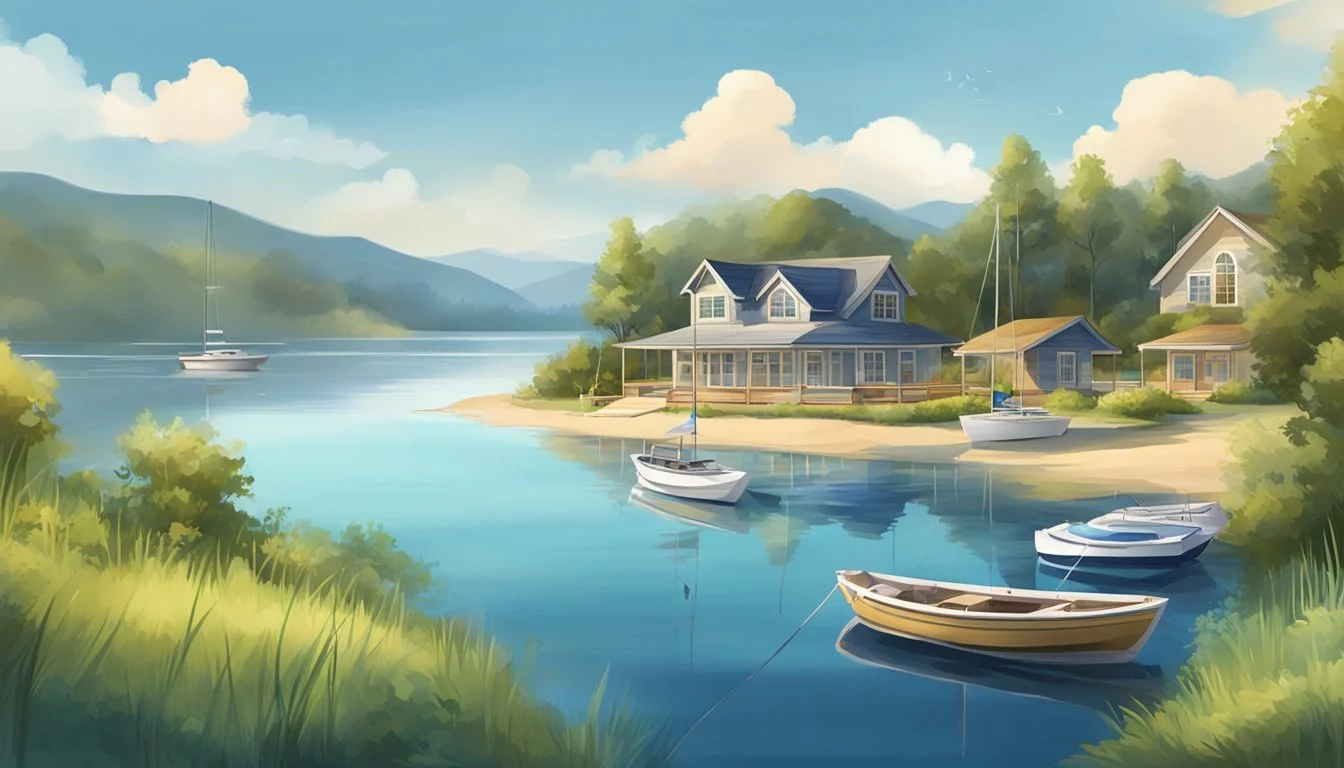Free Land for Boaters
Waterfront Properties Availability and Opportunities
Free land opportunities for boaters can be both exciting and practical for those seeking serene waterfront properties. In certain regions, counties or municipalities may offer land incentives to attract residents or boost local economies, sometimes catering specifically to boating enthusiasts. This can turn your dream of living by the water into an affordable reality.
For those exploring waterfront properties, areas like Duluth, Minnesota present an inviting prospect. Situated along Lake Superior, with a reasonable median home price of $200,800, it’s a location where you can enjoy the beauty of the world's largest freshwater lake along with the St. Louis River and Spirit Lake. Meanwhile, other locations like Greers Ferry, Arkansas offer smaller plots of land with access to tranquil creeks and waterfalls, creating a peaceful retreat for boaters.
Moreover, Florida consistently appears on lists for top boating destinations due to its vast coastal landscape and plentiful opportunities for water-based activities. Waterfront properties in the Sunshine State often come with the bonus of easy access to beaches, urban amenities, and direct boating facilities, making it an ideal choice for those in search of a vibrant coastal lifestyle. These locations provide not just a home but a gateway to the water-based adventures that boaters cherish.
Understanding Waterfront Properties
Waterfront properties present unique opportunities and distinct advantages, but they also come with specialized considerations that buyers need to be aware of.
Different Types of Waterfront Lands
Waterfront lots vary widely, from oceanfront and lakefront to riverfront and bayfront. Oceanfront properties are generally the most valuable due to their stunning vistas and recreational opportunities. Lakefront lands offer serene environments and often attract nature enthusiasts. Riverfront properties provide dynamic landscapes with flowing water, potentially beneficial for activities like boating. Bayfront lots combine elements of both ocean and riverfront settings, typically offering calm waters ideal for various water sports. Pond-side properties bring a more intimate and private waterfront experience, perfect for personal retreats.
Benefits of Owning Waterfront Properties
Owning property with water access often results in higher market value and provides diverse perks. Waterfront homes for sale often come with exclusive recreational opportunities, such as fishing, swimming, and boating. The presence of water can enhance the aesthetic and emotional appeal of the property, creating a tranquil living environment. Additionally, waterfront lands often come with privacy as a natural buffer from neighbors. These properties tend to appreciate well over time, offering solid investment potential for buyers.
Key Factors Defining Waterfront Value
The market value of waterfront properties is influenced by multiple factors. Location plays a critical role; properties closer to urban centers or popular destinations generally command higher prices. Water quality and access are essential, as clean and easily accessible water can significantly boost desirability. Natural disaster vulnerability is another critical aspect; areas prone to flooding or hurricanes may see fluctuating valuations and insurance costs. Erosion considerations and shoreline maintenance can also affect long-term investment value. Buyers need to review local regulations, as stringent rules about development and usage can impact property value and usage possibilities.
By understanding these aspects, buyers can make informed decisions when exploring waterfront properties.
Evaluating Property Listings
When examining waterfront property listings, it is essential to consider market trends, find relevant platforms, and engage professional real estate agents to ensure informed decisions. This section delves into these crucial aspects comprehensively.
Understanding Listings and Market Trends
Evaluating waterfront property listings involves analyzing available data points such as listing age, list price, and sold properties. It's important to compare these figures to the median listing price in the area to identify value opportunities. Tools like Redfin and Zillow provide insights into newest listings and hot homes, which indicate high interest properties that might sell quickly.
Watch for price reductions or properties listed for longer periods, as these might offer negotiation opportunities. Market trends, including home buying and selling patterns, are crucial for recognizing when to make offers. Pay attention to seasonal trends; for instance, summer months may see higher demands for waterfront properties.
Navigating Real Estate Platforms
Real estate platforms such as LandWatch, Realtor.com, and MLS are invaluable tools for locating waterfront properties. They allow users to sort listings by criteria like acres, list price, and listing age. Filters can refine searches by property type, such as those suitable for boating or fishing.
Utilize features like interactive maps to assess the geographical layout and proximity to amenities. Online platforms typically provide extensive property photos, detailed descriptions, and sometimes virtual tours, making it easier to gauge the property’s condition and appeal remotely. The Redfin Buyers and Sellers section offers additional buyer and seller resources, including reviews and ratings of listing agents.
Contacting Real Estate Agents for Waterfront Properties
Engaging a knowledgeable real estate agent can significantly enhance the process of finding the ideal waterfront property. Listing agents specialize in marketing properties, while buyer's agents represent your interests. It's crucial to select agents with expertise in waterfront real estate due to its specific considerations like shoreline conditions and water access.
Real estate agents provide valuable insights into the local market, help arrange property viewings, and negotiate on your behalf. They can also advise on regulatory factors, such as zoning laws and environmental regulations, which may impact property use. Connecting with an experienced agent ensures access to the best properties and smooth navigation through the buying process.
Investing in Waterfront Property
Investing in waterfront property offers significant potential rewards, but also presents unique challenges that must be thoughtfully considered. This section explores market trends, financial considerations, and the regulations impacting waterfront land investments.
Market Analysis for Waterfront Land Investments
The market for waterfront land investments is dynamic, with properties often commanding premium prices. Average list prices for waterfront properties tend to be higher due to the desirable location and limited availability.
Properties with water access are particularly sought-after, often selling faster than non-waterfront properties. Market trends indicate that waterfront properties appreciate in value more rapidly, attracting investors looking for long-term gains.
Buildable waterfront lots can vary significantly in property size, and the average listing age for these properties may be shorter than inland alternatives, reflecting higher demand. Accurate market analysis requires staying informed on current listings and sales data.
Financial Considerations for Purchasing Waterfront Lots
Purchasing waterfront lots involves several financial considerations. Median list prices for these properties are typically higher, reflecting their premium status. Prospective buyers must budget for additional expenses such as higher purchase costs, maintenance, and insurance.
Flood insurance is often mandatory due to the increased risk of flooding, and the cost can be significant. Buyers should also consider environmental assessments to ensure compliance with local regulations and to avoid unforeseen environmental mitigation costs.
Acreage for sale on waterfront properties may range from small lots to expansive tracts, affecting both the purchase price and potential returns. Prospective investors should consult financial advisors and conduct thorough due diligence before committing to a purchase.
Building on Waterfront Property: Regulations and Guidelines
Building on waterfront property comes with specific regulations and guidelines. Local zoning laws often dictate what structures can be built and where, to preserve natural landscapes and prevent environmental damage.
Regulatory restrictions may include limitations on dock and pier construction, septic system placements, and other infrastructure developments. Compliance with these regulations is crucial to avoid hefty fines and potential legal issues.
Additionally, environmental factors such as soil erosion and water quality regulations can impact building plans. It's essential to work with experienced contractors and legal advisors familiar with waterfront development to navigate these complexities effectively.
Property Types and Considerations
Waterfront properties come in various forms tailored to different needs and preferences. Each property offers unique features, benefits, and challenges that potential buyers should assess carefully.
Residential and Commercial Waterfront Properties
Residential waterfront properties include condos, multi-family homes, manufactured homes, and cabins. These properties provide breathtaking views and direct access to water activities. Buyers often prioritize privacy, scenery, and the potential for outdoor recreation.
In contrast, commercial waterfront properties are geared towards businesses such as hotels, restaurants, and marinas. These properties capitalize on high traffic and the scenic appeal to attract customers. The high demand often leads to higher prices, but the potential for profitable business operations can be significant.
Unique Waterfront Properties: Farms, Ranches, and Recreational Lands
Farms and ranches along waterfronts offer a blend of agricultural and aquatic opportunities. These lands are suitable for both crop production and livestock rearing, providing ample space and resources. Water access is crucial for irrigation and livestock needs, making these properties valuable for sustainable agricultural practices.
Recreational lands like vacant lots and dedicated fishing or hunting cabins cater to outdoor enthusiasts. These properties often hold the promise of serene landscapes, natural beauty, and opportunities for outdoor sports. The focus here is on leisure and enjoyment, though development potential must be considered.
Architectural Styles and Design Trends for Waterfront Homes
Waterfront homes showcase diverse architectural styles from modern glass-and-steel structures to rustic log cabins. The design of these homes often emphasizes large windows, open floor plans, and extensive outdoor living areas to blend with the natural surroundings.
Design trends in waterfront properties prioritize sustainability and environmental integration. Native landscaping, green roofs, and energy-efficient systems are increasingly popular. The aim is to complement the natural environment, ensuring that the beauty of waterfront living is preserved and enhanced.
This careful consideration of property types and their unique features is crucial for anyone looking to invest in waterfront real estate.
Location Factors and Accessibility
Locating free land for boaters requires evaluating various factors. Key considerations include accessibility to the water, whether the land is private or public, and the geographic characteristics of different states.
Waterfront Access and Private vs. Public Locations
Waterfront access is crucial for boaters. Waterfront properties offer direct entry to bodies of water, which can include riverfront, beachfront, and lakefront sites.
Private locations provide exclusivity and fewer users, leading to less congestion. Public locations, on the other hand, are more accessible to the general populace but can be crowded. Regulations may impact both types differently, with private land offering more control over dock construction and other modifications.
Analysis of Waterfront Land in Popular States
Different states offer varying types of waterfront land suitable for boating activities. In Florida, for instance, riparian rights allow property owners the privilege to build docks and access marinas.
Texas Hill Country offers ranches and country estates with river frontage, ideal for those valuing privacy and space. States like Virginia grant rights for dock construction but are subject to public rights assurance, which can affect usability.
Analyzing these local regulations and geographical benefits helps in selecting the best state for accessible waterfront living.
Map-Based Searching for Accessible Waterfront Lands
Using map-based searches can streamline the process of finding accessible waterfront lands. Online platforms often provide tools to filter properties by water body type, such as rivers, lakes, and oceans.
Maps allow potential buyers to visualize proximity to amenities and ensure the land meets specific needs like fishing or boating. Additionally, tools that offer satellite views can reveal features like existing docks or secluded bays, making the search more efficient and targeted.
Designing a Waterfront Lifestyle
Waterfront homes offer a unique blend of natural beauty and luxury living. Design elements focus on maximizing views, ensuring comfort, and providing ample amenities for an enhanced lifestyle.
Facilities and Amenities Expected in Waterfront Homes
Waterfront homes are designed to take full advantage of their scenic locations. Common features include large windows and expansive decks to enjoy the views. These homes typically boast 3 to 5 bedrooms and 2 to 5 bathrooms to accommodate families and guests comfortably.
Private docks are popular, providing easy access for boating and fishing. Other amenities may include outdoor kitchens, fire pits, and swimming pools. Indoor features often highlight open floor plans, high ceilings, and luxurious kitchens.
Modern smart home systems are frequently integrated, offering control over lighting, security, and climate. This ensures that homeowners can manage their property efficiently and enjoy a comfortable, tech-enabled lifestyle.
Landscaping and Maintenance of Waterfront Properties
Landscaping for waterfront properties requires specific considerations. Native plants are often chosen for their adaptability to local conditions and minimal maintenance needs. These plants help preserve local ecosystems and reduce erosion.
Maintenance efforts focus on preserving the home’s exterior against the elements. Materials such as cement siding and cedar shingles are popular choices due to their durability and low upkeep requirements.
Efficient irrigation systems are essential, especially for properties covering 25 acres or more. Regular upkeep is crucial for walking paths and any additional facilities like boat storage areas or hunting zones, ensuring a safe and enjoyable environment for activities like whitetail deer hunting.
A well-maintained landscape will not only enhance the property’s beauty but also its functionality and long-term value.
Navigating the Buying and Selling Process
Navigating the complex process of buying and selling waterfront properties requires strategic planning and understanding the nuances of the market. Critical aspects include effective buying strategies, insightful selling advice, and leveraging technology in real estate transactions.
Strategies for Potential Buyers
Potential buyers should first analyze the unique challenges of coastal or riverside properties, such as flood risks and insurance requirements. Consulting a qualified insurance provider can provide essential quotes and additional coverage insights.
Buyers should also investigate local zoning laws and environmental regulations. Understanding riparian rights, or water rights, is essential. Engage with a full-service agent who can provide market comparisons and help negotiate better deals.
Redfin and other industry-leading technology platforms offer data on recent sales and property values, aiding informed decisions.
Advice for Sellers in the Waterfront Property Market
Sellers need to showcase the exclusive lifestyle that waterfront living provides. Emphasize access to water-based activities and scenic views. Highlight property features such as docks and seawalls.
Before listing, it is critical to ensure all necessary permits are in order. Take walkthroughs with realtors to ensure the property is market-ready.
Consider current selling trends and market demand in your region. Engaging a full-service agent might offer lower fees while ensuring a higher selling price. Utilizing platforms like Redfin can aid in aligning property valuation with market trends.
Understanding the Role of Technology in Real Estate Transactions
Technology plays a pivotal role in modern real estate transactions. Industry-leading technology and online real estate platforms provide transparency and ease.
Using tools like Redfin can help both buyers and sellers access market data, schedule virtual tours, and conduct transactions efficiently. Advanced algorithms match buyers with suitable properties, enhancing the overall experience.
Sellers can use technology to create virtual tours, reaching a broader audience and showcasing waterfront views and amenities effectively. Tech-driven insights also assist in setting competitive prices, ensuring properties are appealing in a competitive market.




